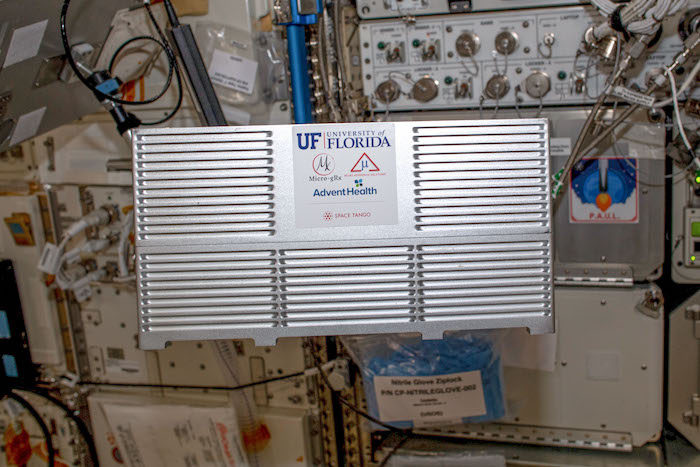UF researcher sends cells to space to understand muscle loss
Adults lose muscle mass and strength as they age. Astronauts in microgravity lose it even faster. University of Florida research led by Siobhan Malany, Ph.D., sends human cells into space to understand muscle loss, which could lead to treatments here on Earth.
“Our experiment should provide some great insight into muscle cell biology by using the unique stress environment of microgravity,” Malany said.
Microgravity speeds up changes to muscle mass, making it possible to study what’s happening to the cells, said Malany, an associate professor of pharmacodynamics in the UF College of Pharmacy. Her most recent experiment — building on space research she did in 2014 and 2018 — launched Dec. 6, 2020 from Kennedy Space Center.
In the experiment, skeletal muscle cells contained on tissue chips are enclosed in a shoebox-size lab that runs itself while aboard the International Space Station. Half the cells came from people under 40, while the other half were collected from adults over 60. Half the cells in each group received electronic stimulation prompting muscle contractions while in space.
After 10 days in space, the experiment returned safely to Earth in January, splashing down in a capsule off the Florida coast. Then Malany and her team began extracting the genetic material in the cells and evaluating the results.
Space Tango, a company that enables research and development and manufacturing in space, worked with Malany’s team to design and build the miniaturized laboratory, which uses an automated system to feed nutrients to the muscle bundles four times a day. Tiny electrodes built into the chips allow scientists to study contractions, while a microscope camera system moves on a rail above the chips collecting images and video that is downlinked from the space station to Earth in near real-time.

The experiment aboard the International Space Station.
The research — funded by the National Institutes of Health and the International Space Station U.S. National Laboratory under contract with NASA and supported by multiple partners, including AdventHealth, Micro-gRx Inc., Micro Aerospace Solutions and the UF Department of Biomedical Engineering — provides hands-on opportunities for students, as well. Tushar Shenoy, part of UF’s University Scholars undergraduate research program, works alongside Malany testing compounds that affect muscle contraction and growth in the tissue chip. After gaining experience in cell culture in Spring 2020, he worked full time over the summer creating 3D differentiated human muscle cells and improving the process that isolates a specific muscle cell type.
“We were able to secure a day badge for Tushar, and he worked on base at the Kennedy Space Center Life Science Lab helping to seed cells into the tissue chips, gaining invaluable experience in contributing to a space-related research project,” she said.
Back on Earth, the findings could unlock treatments for sarcopenia, a condition associated with muscle loss that primarily affects those over 65 and can lead to falls, fractures and mobility problems. Exercise is considered the primary treatment for sarcopenia, as there are no approved drug therapies. Malany hopes her team’s research could change that.
“I feel like our space studies may be impactful for developing therapies on Earth,” she said.
